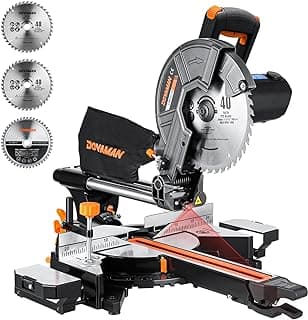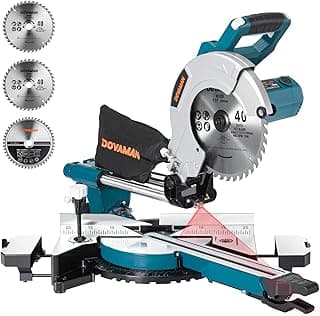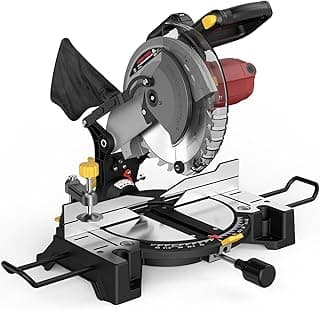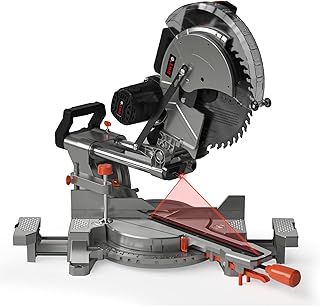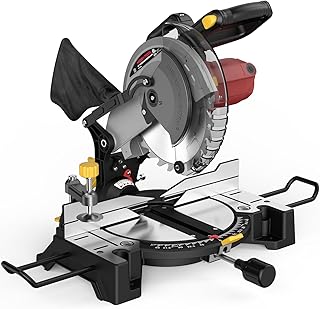Choosing the best lightweight miter saw can be challenging when each model promises power, precision, and easy handling. So where do you begin? Let’s break it down. Many users need a tool that performs well across trim work, deck building, and on-site tasks—yet remains comfortable to carry and set up. But wait—there’s more. The right saw also pairs well with the best miter saw accessories, especially if you're upgrading a workshop or improving efficiency. Professionals looking for on-site performance often compare lightweight models with the best jobsite miter saw, while homeowners may consider whether a compact saw offers enough versatility compared to heavier tools like the best chop saw. This review provides a clear path forward, helping you evaluate cutting performance, usability, and overall value before making a decision.
Top Rated
Best Dual-Bevel Precision: SKIL 10" Dual Bevel Sliding Compound Miter Saw
The MS6305-00 stands out with its strong 1800-watt motor and 4800 RPM speed, giving it enough power for smooth, consistent cuts across demanding materials. Its 10-inch, 40-tooth high-speed steel blade offers clean performance, while the dual-bevel design supports angled cuts without constant repositioning. The saw includes extension rods, a clamp, and a dust bag, which helps streamline setup and handling during longer sessions. Its large footprint and 39.4-pound weight create a stable base, but the size may feel bulky for users working in tight shops. With a brushed finish, durable construction, and a 3-year limited warranty, it positions itself as a reliable option for frequent cutting tasks that require accuracy.
From a user’s perspective, the saw delivers solid value thanks to its power and smooth cutting action. Buyers often appreciate the dual-bevel flexibility because it reduces the time spent adjusting workpieces. The included accessories make the saw usable straight out of the box, which appeals to practical buyers who want minimal setup. However, some may find the weight inconvenient if they need to move the tool between job sites. Overall, it meets expectations for stability, precision, and ease of operation, especially for users who prioritize dependable performance over portability.
Best Shadow-Line Accuracy: SKIL 10 Amp 7-1/4" Single Bevel Miter Saw with Compact Rail System & LED Shadow Line
The MS6306-00 focuses on precision and portability, pairing a 10-amp motor with a 7-1/4-inch carbide blade for clean, controlled cuts on wood. Its LED shadow line system creates an accurate cut indicator without the alignment issues found in traditional lasers, which helps users maintain confidence during repeat cuts. The compact rail system reduces the overall footprint, making it easier to position the saw on small benches or crowded workshops. At roughly 36.6 pounds, it is lighter than many competing models, offering better maneuverability while still maintaining a solid brushed finish and stable structure.
From a customer’s standpoint, the saw’s accuracy and ease of setup tend to be its biggest strengths. Users often appreciate how the shadow line improves cut visibility, especially in varied lighting conditions. Its smaller blade size suits trim work, framing components, and general woodworking but may feel limiting for those needing deeper cuts. Many buyers value the balanced mix of portability, precision, and straightforward operation, making it a practical choice for home workshops and light professional use.
Best Lightweight Power: Metabo HPT 10-Inch Single Bevel Compound Miter Saw
The C10FCG2 emphasizes a strong power-to-weight ratio, delivering a 1950-watt motor in a frame that weighs just 24.2 pounds. Its 10-inch, 40-tooth tungsten carbide blade provides dependable cutting performance on wood, while the wide 52-degree miter range supports diverse angled cuts. The compact dimensions make it easy to position on smaller work surfaces, and the included wrench simplifies blade changes during routine maintenance. With a 5-year warranty, the saw offers reassuring long-term support that stands out among entry-level corded models.
From a user perspective, the light weight is often the biggest advantage because it allows easy movement between work areas without sacrificing stability during operation. Buyers tend to appreciate the smooth cutting action and straightforward controls, especially for home projects and carpentry tasks that require consistent accuracy. At the same time, some may feel limited by the single-bevel design when tackling more complex trim or molding work. Overall, customers see it as a reliable, easy-to-handle option that balances portability with solid cutting performance.
FAQs
What brand is the best mitre saw?
Several well-known brands consistently rank at the top due to their durability, cutting accuracy, and user-friendly designs. DeWalt is often considered the leading choice, thanks to its strong motors, reliable build quality, and smooth bevel and miter adjustments. Makita follows closely, offering saws known for exceptional precision and long-term reliability. Bosch is another standout, especially for users who value innovative features such as axial-glide systems that save workspace. While each brand has strengths, DeWalt remains the most widely recommended among professionals.
What is the best mitre saw for a DIY?
DIY users typically need a saw that balances affordability, ease of use, and consistent performance. A compact, lightweight 10-inch compound miter saw is usually the ideal option because it handles common DIY tasks such as trim work, shelving, and small framing jobs. Many homeowners prefer models with simple controls, clear markings, and a dust collection system that keeps the workspace clean. A cordless option may also be beneficial if mobility is a priority. In most cases, a 10-inch DeWalt or Makita entry-level model meets the needs of typical DIY projects.
Is a 10 or 12 inch miter saw better?
The better choice depends on the type of work you plan to do. A 10-inch saw is lighter, easier to move, and typically less expensive, making it the preferred choice for trim carpentry, molding, and small to medium projects. A 12-inch saw, however, provides greater cutting capacity, allowing you to crosscut wider boards and handle thicker lumber with fewer passes. Professionals working on framing or large wood components benefit from the increased blade diameter. For users who prioritize portability and cost savings, the 10-inch saw remains the better all-around option.
How much does a mitre saw weigh?
Miter saws vary widely in weight depending on size, motor power, and construction materials. Lightweight models designed for portability typically weigh between 20 and 28 pounds, making them ideal for frequent transport. Mid-range saws, especially sliding compound versions, generally fall between 30 and 45 pounds due to added components like rails and extended bevel systems. Heavy-duty 12-inch or professional-grade units can exceed 50 pounds. For users who carry their saw to multiple job locations, weight becomes an important factor in overall usability.
Conclusion
A lightweight miter saw can make a noticeable difference in day-to-day workflow, especially for users who need portability without losing cutting precision. By understanding the strengths of leading brands, comparing blade sizes, and evaluating how the tool fits your project needs, you can select a model that delivers long-term value. Whether you’re a DIY user or a contractor moving between jobsites, the right lightweight saw ensures faster setups, cleaner cuts, and a more efficient overall working experience.





